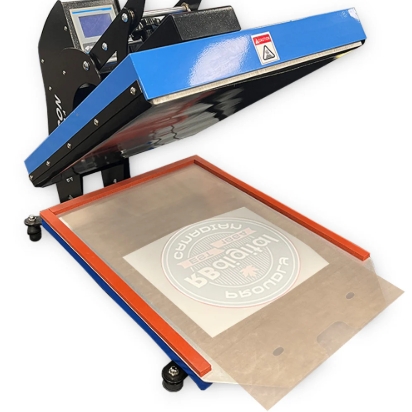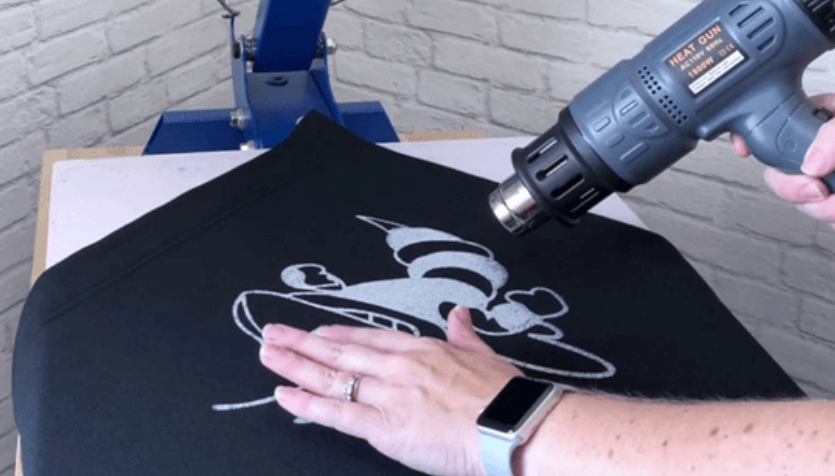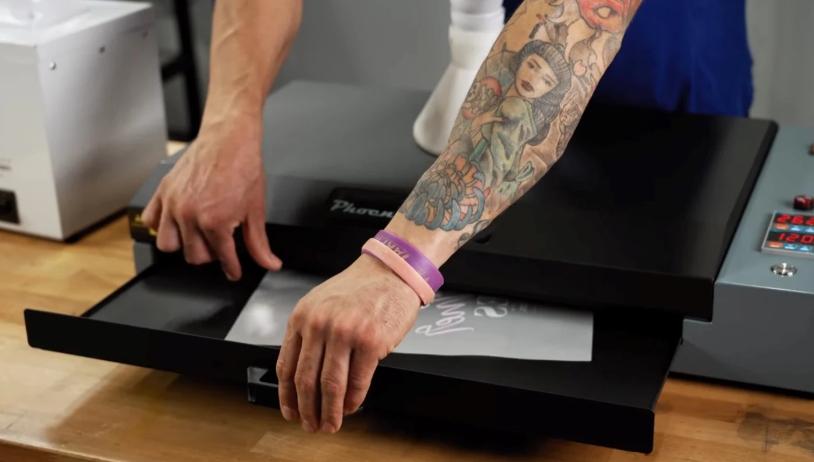Direct-to-film (DTF) printing has gained considerable popularity due to its adaptability and ability to deliver high-quality prints. This printing method enables the transfer of designs onto various fabrics, including cotton, polyester, and even leather, making it both cost-effective and easy to execute. However, the curing stage of the DTF powder is a vital factor in ensuring optimal print quality and durability. Achieving the correct temperature and pressure settings, along with proper handling of the printed material during and after curing, is essential for successful results.
In this blog post, we will explore the techniques for curing DTF powder using a heat gun, heat press, and oven. Additionally, we will discuss some common challenges that may occur throughout the process. Whether you are a beginner in DTF printing or seeking to refine your existing method, this guide will provide valuable insights for achieving superior print outcomes.
Is Curing DTF Powder Necessary?
Absolutely. Properly curing DTF powder is essential for achieving optimal print quality and longevity. As per standard guidelines, most DTF powders require curing for 30 to 60 seconds at temperatures ranging from 320 to 350 degrees Fahrenheit with a pressure setting of 60 to 80 PS. Depending on the specific product, the curing duration may vary, but it typically takes approximately 2 minutes at 325°F (160°C) when using a hovering heat press.
The most commonly recommended methods for curing DTF powder include using a heat press, conveyor dryer, or a specialized shaker/dryer unit. Ensuring that the DTF powder is correctly cured is vital to attaining the desired print quality and durability.
More read:
How to Cure DTF Powder Using a Heat Press

To effectively cure DTF powder using a heat press, follow these steps:
1. Preheat the Heat Press: Set the heat press to the recommended temperature for the specific DTF powder you are using. Typically, the ideal temperature range is between 320 and 350 degrees Fahrenheit.
2. Position the Transfer: Place the printed transfer sheet face down onto the heat press.
3. Protect the Print Surface: Lay a sheet of parchment paper or a Teflon sheet over the transfer to shield the printed surface from direct heat contact.
4. Apply Pressure: Close the heat press and apply pressure for the recommended duration, usually between 30 and 60 seconds.
5. Cool Down: Once the curing time is complete, carefully remove the transfer from the heat press and allow it to cool.
6. Peel Off the Film: Once cooled, gently peel away the transfer film from the printed surface.
7. Repeat if Necessary: If the desired print quality and durability are not achieved, repeat the curing process as needed.
What is the Post-Curing Process for DTF Printing?
After curing the DTF powder, the post-curing process consists of the following steps:
1. Cold Peel: Once the transfer is removed from the heat press, allow it to cool down before peeling off the transfer film from the printed surface. This step, known as cold peeling, helps prevent smudging and ensures a clean finish.
2. Washing: After the transfer film is peeled away, wash the printed material in cold water to eliminate any remaining powder or ink residue. This step is vital to maintain print quality and ensure lasting durability.
3. Drying: Once washed, dry the printed material using a dryer or by air drying. Avoid exposing it to high heat during drying, as excessive heat can compromise print integrity and reduce durability.
4. Storing: Store the DTF print in a cool, dry environment away from direct sunlight to preserve its color and quality. Ensure the material remains flat and uncreased to prevent cracking or peeling.
5. Quality Control: After drying, thoroughly inspect the printed material for any defects or inconsistencies. Conducting a quality check at this stage ensures that the final print meets the desired standards for appearance and durability.
What Are the Correct Steps for Fixing DTF Powder Issues?
If you encounter problems with DTF powder, follow these steps to effectively resolve them:
1. Identify the Problem: Before attempting to fix the DTF powder, assess the specific issue. Common problems include poor adhesion, color bleeding, and low print quality.
2. Adjust the Curing Process: If the problem is related to curing, modify the curing parameters by adjusting the temperature, pressure, or curing duration. Always refer to the manufacturer's guidelines for the specific DTF powder you are using.
3. Utilize a Heat Gun: For adhesion issues, a heat gun can be an effective tool. Hold the heat gun 1-2 inches away from the printed surface and move it in circular motions until the powder melts and properly adheres to the fabric.
4. Consider a Conveyor Dryer: If you are dealing with a large batch of prints, using a conveyor dryer can expedite the curing process. This method is more efficient and consistent compared to using a heat press.
5. Check Ink Quality: If color bleeding or print quality issues occur, inspect the ink quality. Ensure that the ink is compatible with the DTF powder and the type of fabric being used.
6. Reach Out to the Manufacturer: If the problem persists despite troubleshooting, contact the DTF powder manufacturer for further assistance. They may offer additional solutions or replace a defective product.
How to Cure DTF Powder Using a Heat Gun

To effectively cure DTF powder with a heat gun, follow these steps:
1. Prepare the Transfer: Print the transfer using a DTF printer and apply the DTF powder evenly over the printed surface.
2. Apply Heat: Hold the heat gun 1-2 inches away from the printed surface, moving it in a circular motion. Continue heating until the powder melts and fully adheres to the fabric.
3. ooling Down: Once the powder has melted and adhered, allow the transfer to cool down before carefully peeling off the transfer film.
4. Washing the Print: After removing the film, wash the printed material in cold water to eliminate any remaining powder or ink residue.
5. Drying the Material: Dry the printed material using a dryer or by air drying. Avoid high heat, as it can potentially compromise print quality and reduce durability.
It's worth noting that curing DTF powder with a heat gun typically requires more time and effort compared to using a heat press or oven. For optimal results, always adhere to the manufacturer's specific instructions for the DTF powder being used.
What Is the Optimal Temperature for Curing DTF Powder Using a Heat Gun?
When curing DTF powder with a heat gun, the recommended temperature range is 150-160°C (300-320°F). The curing duration will depend on the thickness of the powder layer, typically ranging from 10 to 20 seconds.
How Long Should You Use a Heat Gun to Cure DTF Powder?
The curing time for DTF powder can vary based on the specific powder being used, generally ranging from 30 to 60 seconds. When curing with a heat gun, maintain a distance of 1-2 inches from the printed surface and move the heat gun in circular motions until the powder melts and firmly adheres to the fabric.
Common Mistakes to Avoid When Curing DTF Powder with a Heat Gun
When curing DTF powder using a heat gun, avoid these common pitfalls:
1. Holding the Heat Gun Too Close: Positioning the heat gun too close to the printed surface can lead to uneven melting or burning of the powder. Maintain a distance of 1-2 inches from the surface to ensure even heat distribution.
2. Overheating the Printed Surface: Excessive heat can cause fabric shrinkage or degrade print quality. Always adhere to the manufacturer's temperature guidelines for the specific DTF powder to prevent overheating.
3. Underheating the Printed Surface: Insufficient heat may prevent the powder from properly melting and adhering to the fabric, resulting in poor print quality or peeling. Ensure that the powder is fully melted and adhered before proceeding.
4. Neglecting Protective Gear: Protect yourself by wearing gloves and safety goggles while curing with a heat gun to prevent burns and eye injuries.
5. Skipping the Test Run: Before curing a large batch of prints, perform a test on a small sample to confirm that the curing process produces the desired print quality and durability.
How to Cure DTF Powder Using an Oven

To effectively cure DTF powder using an oven, follow these steps:
1. Preheat the Oven: Set the oven to the specified temperature range for the DTF powder being used, typically between 320°F and 350°F (160°C to 175°C).
2. Place the Transfer in the Oven: Position the printed transfer with the applied powder inside the oven.
3. Cure the Powder: Allow the powder to cure for approximately 2 minutes at 150°C (300°F) or until the powder has fully melted and adhered to the fabric. The curing time may vary based on the specific DTF powder, but it generally takes around 2 minutes at 325°F (160°C) using a hovering heat press.
4. Cooling Down: Once the curing time has elapsed, carefully remove the transfer from the oven and let it cool down completely.
5. Peel Off the Transfer Film: After the print has cooled, peel away the transfer film from the printed surface.
6. Repeat if Necessary: If the desired print quality and adhesion are not achieved, repeat the curing process to improve the outcome.
What Is the Ideal Temperature Range for Curing DTF Powder in an Oven?
The optimal temperature range for curing DTF powder in an oven is typically between 320°F and 350°F. However, the exact temperature and curing time may differ based on the specific DTF powder being used, so it is essential to follow the manufacturer's guidelines for best results.
How Long Should DTF Powder Be Cured in an Oven?
The curing duration for DTF powder in an oven may vary based on the thickness of the powder layer, typically ranging from 2 to 10 minutes at 150°C (300°F) or until the powder has completely melted.
How Can You Tell When DTF Powder Is Fully Cured?
To determine if DTF powder is fully cured, follow these steps:
1. Check Manufacturer's Guidelines: Start by reviewing the specific instructions provided for the DTF powder being used, as curing time and temperature can vary depending on the product.
2. Observe the Curing Process: As the DTF powder cures, it will first appear sparkly before melting into a smooth, uniform layer. Monitor this visual change to assess when curing is complete.
3. Use a Timer: Ensure that the DTF powder is cured for the recommended duration. Typically, most DTF powders require curing for 30 to 60 seconds at temperatures between 320°F and 350°F (160°C to 175°C) with a pressure setting of 60 to 80 PSI.
4. Cooling Down: After the specified time, remove the transfer from the heat press, oven, or heat gun and allow it to cool before proceeding.
5. Peel Off the Film: Once the transfer has cooled, carefully peel away the transfer film from the printed surface.
6. Inspect the Print: Examine the printed material for any inconsistencies or defects. If the print quality is unsatisfactory, repeat the curing process as needed.
7. Washing Test: Follow the manufacturer's washing instructions to assess the print's durability and adhesion after curing.
Troubleshooting During the Curing Process of DTF Powder
Addressing potential issues when curing DTF powder is vital to maintaining print quality and ensuring a smooth printing process. Here are some common problems and their solutions:
1. Ink Not Adhering Properly:
If the ink fails to penetrate the fabric effectively, it may result in flaking or rapid fading. To resolve this, regularly clean the printhead and ink tubes and replace the ink cartridge every two months to maintain optimal ink flow.
2. Powder Sticking to Unprinted Areas:
Powder adhering to unprinted sections of the film can occur due to humidity during storage, printing, or powder shaking. To prevent this, store the film in a dry area and consider using a dehumidifier when necessary.
3. Powder Sticking Around the Design Area:
When moisture in the film evaporates into the DTF ink, it can extend drying time, causing the powder to stick around the design. Ensure that the film is thoroughly dried before printing to minimize this issue.
4. Improper Curing of DTF Prints:
If the print is not curing correctly, it may be due to incorrect temperature settings, insufficient curing time, or uneven heat distribution. Adjust the curing temperature and duration, and verify that the curing process is consistent throughout the entire print.
5. Excessive Powder on the Film:
Using too much powder or failing to shake off excess powder can result in clumping. To prevent this, apply the appropriate amount of powder and thoroughly shake off any excess before curing.
6. Peeling and Cracking of Prints:
If the print shows signs of peeling or cracking, it may indicate insufficient drying or improper storage. Ensure that the print is completely dried and store it in a cool, dry location away from direct sunlight to preserve its quality.
Conclusion
For manufacturers and printing businesses, ensuring optimal print quality and durability in DTF printing is crucial to maintaining a competitive edge. By implementing effective curing techniques using a heat press, heat gun, or oven, you can guarantee that each transfer adheres flawlessly to a variety of fabrics. Following the manufacturer's recommended temperature and timing settings not only enhances print adhesion but also minimizes production errors, reducing waste and increasing efficiency.
At Hanze, we provide top-tier DTF printing solutions, from premium-grade powders to advanced curing equipment, designed to streamline your production process and elevate your print quality. Partner with us to access cutting-edge products and expert support that will help you achieve vibrant, durable prints every time. Connect with us today to learn more about optimizing your DTF printing workflow and boosting your production efficiency.

FAQ for DTF Powder Curing
Can I Cure DTF Powder Without a Heat Gun, Heat Press, or Oven?
Yes, while heat guns, heat presses, and ovens are the most common methods for curing DTF powder, you can also use a conveyor dryer or infrared heater. However, maintaining consistent temperature and timing is crucial to ensure print quality.
Why Does My DTF Print Feel Sticky After Curing?
A sticky print surface may indicate that the powder is not fully cured. Ensure the correct temperature and time settings are followed based on the manufacturer's guidelines. Also, allow the print to cool completely before handling.
How Can I Prevent Color Fading in DTF Prints Over Time?
To minimize color fading, use high-quality DTF inks, cure the powder at the recommended temperature, and wash the printed garment inside out using cold water. Avoid using harsh detergents and high-heat drying methods.
What Are the Signs of Overcured DTF Powder?
Overcured DTF powder can appear overly hardened, brittle, or cracked. Additionally, the print may exhibit a yellowish tint, indicating that the temperature was too high or the curing duration was too long.
Can I Re-Cure a Print That Didn't Adhere Properly the First Time?
Yes, you can attempt to re-cure the print by applying moderate heat with a heat gun or heat press. Ensure that the powder fully melts and adheres to the fabric without overheating.
How Do I Store Unused DTF Powder to Prevent Clumping?
Store DTF powder in a cool, dry place away from direct sunlight and humidity. Seal the container tightly to prevent moisture from affecting the powder's consistency.
Can I Use the Same Temperature for All Fabric Types When Curing DTF Powder?
No, different fabrics may require slightly different curing temperatures. For instance, polyester may require a lower temperature than cotton to prevent scorching. Always refer to the manufacturer's recommendations for specific temperature settings.
What Should I Do If the DTF Transfer Film Tears During Peeling?
If the transfer film tears during peeling, it may indicate that the film was not adequately cooled or the curing temperature was too high. Allow the print to cool completely and try peeling again.
How Can I Test the Durability of a Cured DTF Print?
To assess the durability, perform a wash test using cold water and mild detergent. Check for signs of fading, cracking, or peeling. Additionally, lightly stretch the fabric to see if the print maintains its integrity.
Is It Possible to Mix Different Brands of DTF Powder and Inks?
While technically possible, mixing different brands of DTF powder and ink may lead to inconsistent results. For optimal adhesion and print quality, it is advisable to use products from the same brand or consult with the manufacturer.















